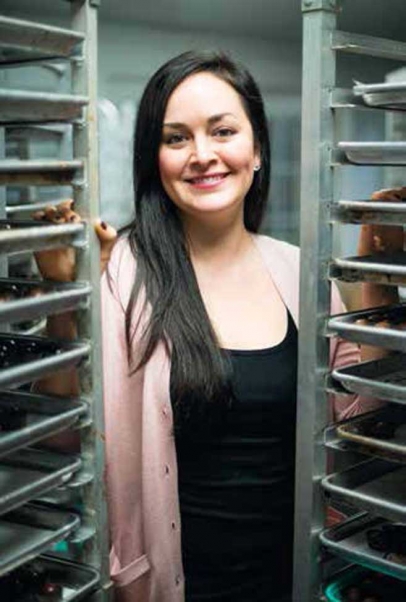Chocolate: Sweet Smell of Success
Cellar Door Founder Sees Opportunities
Erika Rosa Ramoncita Jesusito Graziano Chavez could easily be the subject of a business school start-up case study. On the other hand, her story might just as well be told as an inspiring tale of a local woman’s charm, tenacity and entrepreneurial success in the face of challenging circumstances.
Her biography does read a lot like a contemporary American success story. This is the fascinating account of how a little girl who played “bank” instead of “house” and learned from her mother how to fill out the long form for federal income taxes at age 12 and always sold the most Girl Scout cookies in her troop came to be the founder of Cellar Door Chocolates.
“My journey has not been planned,” Erika explains. “I adapt my busi ness to what the market wants. I adapt my life to where it wants me to go. I’m not on the path I set out to be on, but the entrepreneurial spirit within me has always been there. I just didn’t know that it was going to manifest itself in the role of chocolate.”
(She did, however sell chocolate bunnies for Easter at church to help raise money—more money, apparently, than any of the other Sunday school students.)
Erika was driven to succeed at an early age. “Anything that involved fund-raising, I was always the best. It felt good. It became a personal goal of mine. I knew then that I wanted to do something in business.”
GRANDMOTHER'S KITCHEN
Erika’s grandmother played a decisive role in determining the course of her life.
“How I got into chocolate is a side story. Because my mother was a single mother, my grandmother helped raise us. She had eight children and 27 grandchildren, of which I’m the oldest. We grew up in her kitchen in Albuquerque, New Mexico. She fostered within me a love for food.”
Erika describes cooking as an act of love, modeled by her grandmother. “The act of making food for someone is the ultimate selfless act because you are laboring over something to nourish someone else, and a lot of the time when you’re done, you don’t even want to eat. You’re just happy to sit next to the person and watch them eat. It’s just such a good feeling. It’s how Grandma expresses her love, and I think that carried on to me.”
CHALLENGES AND OPPORTUNITIES
As a bright student, Erika earned scholarships and attended college and graduate school. “I’m in college, and I bake to relieve stress. Then I’m in graduate school, and I’m still making chocolates for family and friends. I’m going through a divorce. I want to leave my department. At that point I am 26. I decide to abandon my thesis. My mentor in school asks, “Why don’t you do something with your chocolates?” And I said: “Why the hell not?”
Erika smiles in a delightfully self-deprecating manner as she recalls this chapter of her life
“Doing something with your chocolates” could mean many things and lead down remarkably different paths. Some would-be entrepreneurs might invest in equipment, others might perfect their recipes and still others live inside an Excel spreadsheet demonstrating market share or cash flow.
At this point, Erika recalls that she had been in Louisville for about a year and a half and was actually wondering if she should go back to Albuquerque or stay in town.
“Then I met this guy, and I wanted to stay here to be with him. There were things here I’d never seen before, like this amazing sense of community, which isn’t everywhere. It really is not!”
THE HARDEST VARIABLE
Erika says she asked herself what she would have to do to make money really quickly to stay in Louisville.
“I made a couple of hundred truffles and boxed them up and went around town and cold-called people.” Her pitch was simple and direct. “Hey, I’m Erika. If I start a company, will you carry this?” Some people said no, and a lot of people said yes.
She thinks the right people said yes, so she proceeded to form her company, organized as an LLC.
“I have the ability to look at a situation and distill it down to the single most important variable and tackle that first. Once I tackle the hardest variable, I can work my way back from it. I knew that sales was the hardest variable.”
When asked how she managed to figure that part out, she suggests that it came naturally. “Maybe it was the Girl Scout cookie experience. You know you want to go to Girl Scout camp. What do you have to do? Better sell those damn cookies. That is how I approach my business even today. It’s easy to make chocolate. As a matter of fact, it’s so easy that many people are forming chocolate companies. It’s easy enough to start.
It’s not so easy to sell, and it’s certainly not easy to stay relevant and it’s definitely not easy to compete.”
When she started out, Erika wanted to sell an ultra gourmet truffle line but her thinking quickly evolved. “I realized that there was a deficit for ultra gourmet truffles. It wasn’t that there wasn’t anything good on the market. I would be obtuse to think that I was going to fill a hole where there was no good chocolate. There are plenty of good chocolatiers in this state. I just knew I had to find a hole they were leaving that I could insert myself into.”
Enter a new boyfriend. “He told me that my truffles were all really great chocolates, but I needed to make some simple, popular items. I was making chocolate with cayenne pepper, green chili, ginger, all great flavors—but they were a little ‘out there.’” He told her to make some candy that everybody likes, so people would begin to trust her.
“Being 27 at the time, I rolled my eyes but did it eventually. And he was right. Peanut butter cups and almond bark. Those are his things. And now, that’s why I think we are still together—because I keep him in chocolate!
In business, you have to do something people are already comfortable with. You build a relationship with them, and then you can introduce them to interesting things, or what you consider to be interesting.”
Today, Cellar Door’s best-selling item is sea salt caramel. Erika admits that she certainly is not the first person to do sea salt caramel, but instead focuses on doing a very good version. Peanut butter cups also sell well. Erika believes that Cellar Door peanut butter cups are unique because they contain puffed riced and are crispy and crunchy. The truffles are unique as well, because of the chocolate that is used. Ingredient lists are short and the quality is high.
The same thing may be said of the bourbon balls: high-quality ingredients combined with Cellar Door’s spin on what a bourbon ball is.
GROWING PAINS
When asked about the growth of her organization, Erika noticeably sits up a little straighter, and assumes a poised, direct manner.
“Every year, we’ve grown. And to do that, I’ve had to do one or two things that have made me terribly uncomfortable.
In growing, I couldn’t make all the chocolate and manage the store, so I had to surrender the kitchen and the chocolate to another talented person. Then I had to feel comfortable letting her share our secrets with other employees, and then I had to feel comfortable with the fact that not only am I not making all the chocolates anymore, but that I’m not always going to be the person in the front of the house. This has been happening every year.”
Erika speaks with a confident conviction that cannot be faked and evident pride when she speaks of her relationship with her employees. “An employer has to trust and respect the employee. At the same time, the employee has to trust and respect the employer. Over a period of years, I had to earn their trust, as much as they earned mine.”
Hers is a young organization, and she is keenly aware that most new companies don’t make it past their first three years. Her employees watched her closely, she says. “They watched our growth, watched my decisions. Because they have come to trust me, since moving to Butchertown in 2010, I have the freedom to make uncomfortable decisions and be supported. So it’s like a cushion. Even when I’m feeling doubtful about something, they make me feel better about a situation, reminding me of past successes. Sometimes they even challenge me, which is good.”
There have been the inevitable mid-course corrections and learning opportunities. “I’ve made mistakes: I opened up a shop in the Galt House Hotel and closed it after a year because it was more work than it was worth. Yes, I’ve made mistakes, but it hasn’t stopped me.
ERIKA’S RULES
The atmosphere in Cellar Door’s kitchen is at once delightfully aromatic—and productive. Everyone seems gracious, respectful and engaged in the work. When asked how this environment was created, Erika says that she hires a specific kind of person.
“I can train you to make chocolate. I can’t teach you to be a nice person. I can’t teach you to be respectful of others. And I can’t teach you not to be a jerk!
The girls know I take it upon myself to create a safe work environment for them. They never have to deal with a passive-aggressive owner or peers. They know that they will never leave work emotionally exhausted. It’s my job to keep them safe. Even if I meet a woman or a man who is fantastic at what they do, I’m not going to bring them in if they’re a jerk. It would bring down the whole crew.”
FUTURE PLANS
In late March or early April, Cellar Door will open a boutique outlet at Fourth and Chestnut featuring a hot chocolate bar. Erika also has plans in the works to open a “bean to bar operation” within her Butchertown location, utilizing space in the Jackknife Café. Cellar Door will begin sourcing and importing beans from South America to share with her customers the distinct flavors of chocolate from Peru and perhaps Venezuela.
Chocolate and wine are similar: terroir is a critical determinant for flavor... There is only so much that can be done with grapes or cacao beans after they have been harvested. Ever the entrepreneur with a degree in economics, Erika is quick to point out that financial realities will guide her and provide a solid foundation for the new endeavor.
Cellar Door is certified as “Kentucky Proud” and will become the only firm in Kentucky transforming raw cacao beans into chocolate bars. She plans to begin importing, roasting and winnowing, the process whereby the beans are separated from the husks. Potentially, the husks might be used for tea. The nibs (the beans before they are further processed into chocolate) might be marketable to local chefs for baking. Clearly, Erika continues to scan the market for multiple streams of revenue.
When asked what surprises her, Erika is quick to reply: “How little I know. I am always learning something new.” This sort of humility cannot be feigned, suggesting an altogether charming blend of ambition and business acumen allowing for experimentation and midcourse correction, which bodes well for the future of Louisville’s first “bean to bar” producer of locally crafted chocolate.
CHOCOLATE EDUCATION: CACAO NIBS
According to Baking Bites, cacao nibs are basically raw chocolate, pieces of cacao beans that have been roasted, hulled and prepped to the point where all that there is left to do is process them into bars. The chocolate-making process involves grinding up the cacao into a thick paste to which extra cacao butter, sugar, milk and other flavorings are added. Nibs, on their own, taste vaguely similar to roasted coffee beans. Nibs are a bit crunchier than coffee beans, since some coffee beans can become quite delicate after roasting, but give primarily the same textural effect when covered in chocolate. Cacao nibs are always found in small pieces, rather than coffee bean-sized pieces.
The flavor is slightly nutty and, while there are definitely some chocolate notes in there, they are primarily going to contribute texture and a hint of bitterness (the same as raw cocoa powder). Some beans will have a more complex flavor, but generally coffee beans will have a more interesting taste on their own. Cacao nibs do serve to draw out darker notes in chocolate, which is why they are such a popular addition.
You’ll generally see cacao nibs incorporated into other chocolate products, or simply covered in chocolate and sold as a snack. They are also sold apart, intended to be used as a mix-in for baked goods or sweets. You can use them in addition to, or in place of, chocolate chips or nuts in a cookie, for instance. They can be eaten on their own, too, but as is the case with coffee beans, they’re almost always better with something else.















